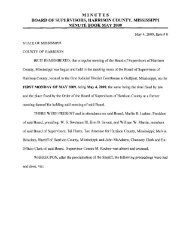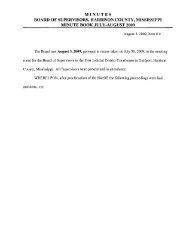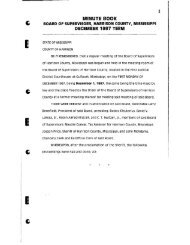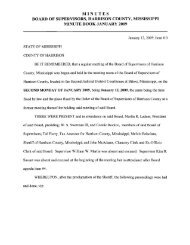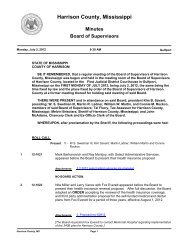minutes board of supervisors, harrison county, mississippi minute
minutes board of supervisors, harrison county, mississippi minute
minutes board of supervisors, harrison county, mississippi minute
You also want an ePaper? Increase the reach of your titles
YUMPU automatically turns print PDFs into web optimized ePapers that Google loves.
Natural Hazards in the post disaster environment are magnified because such<br />
disasters upset the natural order <strong>of</strong> the area and wildlife will be displaced and<br />
more aggressive as a result. Standing water leads to insect breeding on a<br />
greater scale and workers will interact with insects and plants normally only<br />
found in deep woods environments.<br />
4.3.1 Arachnids are exposed in post disaster circumstances and much more<br />
frequently encountered than normally. Spiders are a particular concern as<br />
many varieties have poisonous venom. Two types <strong>of</strong> spiders common to<br />
Harrison County are Black Widows and Brown Recluses. Information on<br />
identifying and dealing with these spiders can be found in Appendix B <strong>of</strong><br />
this document.<br />
4.3.2 In a post disaster environment, especially if flooding was a factor,<br />
mosquitoes are a severe problem and hazard for workers. Workers<br />
should use insect repellent containing DEET or Picaridin on exposed skin<br />
and wear long pants and long-sleeved shirts. Efforts should be made to<br />
remove all nearby sources <strong>of</strong> stagnant or standing water. Additional<br />
information on avoiding mosquito related illness and specifically West Nile<br />
disease can be found in Appendix C <strong>of</strong> this document.<br />
4.3.3 Although new evacuation guidelines from FEMA make accommodations<br />
for pets in a disaster scenario, there will still be a number <strong>of</strong> abandoned pets,<br />
strays and wild animals aggravated by events. Workers should do the<br />
following:<br />
a.) Assume that all animals are rabid.<br />
b.) Be on guard for stray or wild animals, as they can exhibit unpredictable<br />
or aggressive behavior.<br />
c.) Do not attempt to take custody <strong>of</strong> animals-watch them from a safe<br />
distance while contacting animal control personnel.<br />
4.3.4 In a post disaster environment, it is not unusual for snakes to be driven<br />
from their natural habitat into more exposed areas. Debris <strong>of</strong> any kind can<br />
provide a safe haven for snakes <strong>of</strong> many varieties. Workers should follow<br />
these gUidelines to prevent accidentally disturbing snakes and risking a<br />
bite:<br />
a.) Assume that all snakes are poisonous.<br />
b.) Be cautious about where you place your hands and feet. Do not put<br />
your hands in holes or under objects (e.g., lumber, scrap metal,<br />
overturned boats) without checking to see if snakes are present.<br />
c.) Do not sit or lie down in areas where snakes could be present (e.g.,<br />
wood piles, high vegetation).<br />
d.) Wear proper foot gear, such as high-top leather boots and leather<br />
gloves when handling material where snakes may have nested (e.g.,<br />
firewood, lumber, rocks, construction debris). Refer to Appendix H for<br />
more information on snake hazards.





